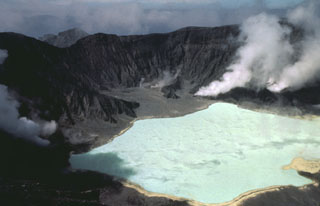Report on El Chichon (Mexico) — February 1993
Bulletin of the Global Volcanism Network, vol. 18, no. 2 (February 1993)
Managing Editor: Edward Venzke.
El Chichon (Mexico) Fumarolic activity continues; lake chemistry unchanged
Please cite this report as:
Global Volcanism Program, 1993. Report on El Chichon (Mexico) (Venzke, E., ed.). Bulletin of the Global Volcanism Network, 18:2. Smithsonian Institution. https://doi.org/10.5479/si.GVP.BGVN199302-341120
El Chichon
Mexico
17.3602°N, 93.2297°W; summit elev. 1150 m
All times are local (unless otherwise noted)
Fieldwork on 11-18 January revealed continued fumarolic activity around the crater lake and crater walls as observed in June 1992 (17:06). The boiling mud and water ponds remained active. Geyser-like fumaroles emitted a gas phase only, and extensive mud cracks indicated an 85 cm drop in the level of the crater lake. The changes were probably due to the decrease in rainfall during December and January.
The drop in lake level prevented temperature and pH measurements at the same sites sampled last June. Two new sites were chosen. Site 1, which better reflected the ambient conditions of the lake because of the absence of nearby fumaroles or boiling zones, had a temperature of 30.7°C and a pH of 2.3. The temperature at site 2 was 66.6°C and its pH was 1.7. Analysis of a water sample taken at site 1 indicated that the lake has remained chemically stable since 1992 except for minor boron variations.
On 13 January, two apparent phreatic explosions similar to one reported last year were heard and felt on the crater rim. A small rockfall avalanche on the SE inner wall of the crater followed the first explosion.
Geological Summary. El Chichón is a small trachyandesitic tuff cone and lava dome complex in an isolated part of the Chiapas region in SE México. Prior to 1982, this relatively unknown volcano was heavily forested and of no greater height than adjacent non-volcanic peaks. The largest dome, the former summit of the volcano, was constructed within a 1.6 x 2 km summit crater created about 220,000 years ago. Two other large craters are located on the SW and SE flanks; a lava dome fills the SW crater, and an older dome is located on the NW flank. More than ten large explosive eruptions have occurred since the mid-Holocene. The powerful 1982 explosive eruptions of high-sulfur, anhydrite-bearing magma destroyed the summit lava dome and were accompanied by pyroclastic flows and surges that devastated an area extending about 8 km around the volcano. The eruptions created a new 1-km-wide, 300-m-deep crater that now contains an acidic crater lake.
Information Contacts: José Luis Macías, Michael F. Sheridan, and Carmelo Ferlito, SUNY, Buffalo, NY; Juan Manuel Espíndola, Servando De la Cruz-Reyna, and M. Aurora Armienta, Instituto de Geofísica, UNAM.

